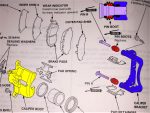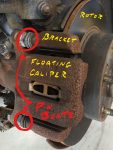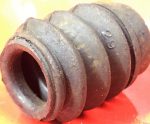We had so much interest in our “What’s That Wednesday” social media post that we decided to expand on it a bit. The “mystery part” we showed was a brake caliper slide pin boot. But what exactly is that?
Cars these days all have disc brakes. The main parts include names like; brake pads, calipers, rotors or discs. The brake caliper is hydraulically operated (essentially by your foot) and is responsible to clamp down on the brake pads to create friction against the rotating brake rotor. The wheel is bolted to the brake rotor.
While there are several designs for brake calipers, the most common type is the “floating” caliper. This has two main sections… a bracket (blue in the picture), which solidly mounts to a suspension component. The caliper body (yellow in these pictures), which must “float” to allow both application of both brake pads as well as the ability to release the brakes when the light turns green.
 The floating section is bolted to two pins called slide pins (lavender color in the picture). These pins are greased and allow for proper alignment of the caliper to the brake rotor and still allow for the movement needed under normal driving.
The floating section is bolted to two pins called slide pins (lavender color in the picture). These pins are greased and allow for proper alignment of the caliper to the brake rotor and still allow for the movement needed under normal driving.
“Pin Boots” are small tubular, ribbed rubber components (red in the picture) that snap into grooves in the slide pin and also the fixed caliper bracket. Their job is to keep the water, sand and dirt away from the slide pin bores and helps keep the special grease inside.
 When pin boots don’t keep the bad stuff out anymore, the pins can seize. Most of the time, this condition causes the brake to have trouble releasing or letting go when you drive off. Since the brake is dragging, the subsequent heat buildup will rapidly cause brake pad wear and rotor warpage. The car may pull to one side or the other and essentially the car will not stop like it was designed to.
When pin boots don’t keep the bad stuff out anymore, the pins can seize. Most of the time, this condition causes the brake to have trouble releasing or letting go when you drive off. Since the brake is dragging, the subsequent heat buildup will rapidly cause brake pad wear and rotor warpage. The car may pull to one side or the other and essentially the car will not stop like it was designed to.
Whenever we service your car, these get inspected as part of a professional brake inspection. Here is one inexpensive routine maintenance item that can save HUGE dollars in repairs. – Greg

